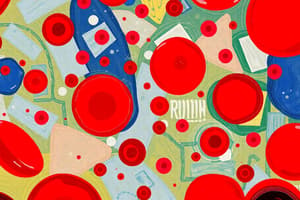Podcast
Questions and Answers
What is the primary function of erythrocytes in the blood?
What is the primary function of erythrocytes in the blood?
- Blood clotting
- Production of antibodies
- Transport of respiratory gases (correct)
- Defense against infections
Which of the following white blood cells is the least abundant?
Which of the following white blood cells is the least abundant?
- Basophils (correct)
- Monocytes
- Eosinophils
- Neutrophils
Where is the primary site for the destruction of red blood cells?
Where is the primary site for the destruction of red blood cells?
- Bone marrow
- Liver
- Kidneys
- Spleen (correct)
What is the typical life span of an erythrocyte?
What is the typical life span of an erythrocyte?
Which type of white blood cell is primarily involved in phagocytosis?
Which type of white blood cell is primarily involved in phagocytosis?
Flashcards are hidden until you start studying
Study Notes
Formed Elements of Blood
- Formed elements make up approximately 15% of blood by volume.
- Formed elements include:
- Erythrocytes (red blood cells)
- Leukocytes (white blood cells)
- Platelets
Erythrocytes
- Also known as red blood cells.
- Found in the blood of healthy adult males at a concentration of 5-5.5 million per mm³.
- Biconcave disc shape.
- Typically lack a nucleus in most mammals.
- Primarily responsible for transporting respiratory gases, including oxygen and carbon dioxide.
- The oxygen transport is facilitated by the presence of haemoglobin.
- Erythrocytes have a lifespan of approximately 120 days.
- The spleen is the primary site for the destruction of aged erythrocytes.
- Normal haemoglobin content in blood ranges between 12-16 grams per 100 ml.
Leukocytes
- Also known as white blood cells.
- Found in the blood at a concentration of 6000-8000 per mm³, generally fewer than erythrocytes.
- Act as the body's primary defense against foreign organisms and infections.
- Two main categories:
- Granulocytes:
- Neutrophils: The most abundant granulocyte (60-65%), known for their phagocytic activity.
- Eosinophils: Present in a smaller percentage (2-3%). They participate in resistance to infections and allergic reactions.
- Basophils: The least abundant granulocytes (0.5-1%). Basophils secrete histamine, serotonin and heparin, playing a role in inflammatory reactions.
- Agranulocytes:
- Lymphocytes: Account for 20-25% of leukocytes. They are involved in antibody production (B-lymphocytes) and cell-mediated immunity (T-lymphocytes).
- Monocytes: Present in 6-8% of leukocytes. They function as phagocytic cells.
- Granulocytes:
Platelets
- Essential for blood clotting.
Studying That Suits You
Use AI to generate personalized quizzes and flashcards to suit your learning preferences.




